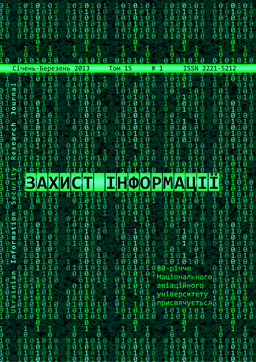Модель засобів захисту друкованих документів
DOI:
https://doi.org/10.18372/2410-7840.15.4220Ключові слова:
рівень захищеності, друкований документ, засіб захисту, технологічні характеристики, споживчі факториАнотація
Кількість засобів захисту щодо друкованих документів на сьогоднішній день зростає для скорочення та зведення до мінімуму несанкціонованого доступу до інформації на матеріальних носіях. Є потреба у розробленні моделей засобів захисту для того, щоб унеможливити підробки. Проаналізовано, що модель засобів захисту утворюється під дією технологічних факторів виготовлення документів, поєднання засобів захисту та споживчих характеристик друкованого документу. Показано, що існує шість факторів впливу на споживчі характеристики: величина накладу документа, час існування документів, швидкість обігу документів, глибина контролю, інтенсивність обміну та ступінь наявності захисту друкованого документу. Використання моделей засобів захисту зробить можливим створити оптимальні засоби захисту для конкретного документу з його функціональними особливостями, а також розраховувати систему впливів на рівні захищеності документів.
Посилання
Бобылева М. П. Управленческий документооборот: от бумажного к электронному / Бобылева, Марина Павловна ; М. П. Бобылева. – М. : Изда-тельский дом МЭИ, 2010. - 295 с.
Киричок П. О. Захист цінних паперів та документів суворого обліку [Текст] : моногр. / П. О. Киричок, Ю. М. Коростіль, А. В. Шевчук. – К. : НТУУ «КПІ», 2008. – 368 с.
Український національний комітет міжнародної торгової палати [Електронний ресурс] : – Режим доступу : http://www.ukrexport.gov.ua
Швецова-Водка Г. Н. Общая теория документа и книги. М.: Рыбари, 2009, - 491 с.
Шевчук А. В. Теоретичні основи побудови інформаційних технологій захисту поліграфічної продукції спеціального призначення [Текст]: Ав-тореф. дис. д-ра техн. наук: 05.13.06 / А. В. Шевчук. // Державний комітет зв’язку та інформатизації України. – Львів, 2004. – 34 с.
Шевчук А. В. Система захисту цінних паперів та документів суворого обліку – наукоємна проблема державного масштабу [Текст] / А. В. Шевчук, В. П. Музика // Друкарство. – 2002. – № 4(45). – С. 72 –74.
Bobileva M.P. Workflow management: from paper to electronic / M.P. Bobileva. - M. : MEI Publishing, 2010. , 295 p.
Kirichok P.O. Protection of securities and docu-ments of strict accountability [Text]: Monograph. / P.O. Kirichok, Yu.M. Korostil, A.V. Shevchuk., K. : NTUU «KPI», 2008, 368 P.
Ukrainian National Committee of the International Chamber of Commerce [electronic resource]: Avail-able at: http://www.ukrexport.gov.ua
Shvetsova-Vodka G.N. General theory of docu-ments and books. M.: Ribary, 2009, 491 p.
Ukrainian National Committee of the International Chamber of Commerce [electronic resource]: Avail-able at: http://www.ukrexport.gov.ua
Shvetsova-Vodka G.N. General theory of documents and books. M.: Ribary, 2009, 491 p.
Shevchuk A.V. Theoretical bases of information technology security printing products for special purposes [Text]: Author. Thesis. Dr. techn. sciences: 05.13.06 / A.V. Shevchuk // State Committee of Communications and Informatization of Ukraine. - Lviv, 2004. - 34 p.
Shevchuk A.V. Protection System securities and documents of strict accounting – science intensive national scale problem [Text] / A.V. Shevchuk, V.P.Muzika // Drukarstvo, 2002,№ 4(45), P. 72 –74.
##submission.downloads##
Опубліковано
Номер
Розділ
Ліцензія
Автори, які публікуються у цьому журналі, погоджуються з наступними умовами:- Автори залишають за собою право на авторство своєї роботи та передають журналу право першої публікації цієї роботи на умовах ліцензії Creative Commons Attribution License, котра дозволяє іншим особам вільно розповсюджувати опубліковану роботу з обов'язковим посиланням на авторів оригінальної роботи та першу публікацію роботи у цьому журналі.
- Автори мають право укладати самостійні додаткові угоди щодо неексклюзивного розповсюдження роботи у тому вигляді, в якому вона була опублікована цим журналом (наприклад, розміщувати роботу в електронному сховищі установи або публікувати у складі монографії), за умови збереження посилання на першу публікацію роботи у цьому журналі.
- Політика журналу дозволяє і заохочує розміщення авторами в мережі Інтернет (наприклад, у сховищах установ або на особистих веб-сайтах) рукопису роботи, як до подання цього рукопису до редакції, так і під час його редакційного опрацювання, оскільки це сприяє виникненню продуктивної наукової дискусії та позитивно позначається на оперативності та динаміці цитування опублікованої роботи (див. The Effect of Open Access).

